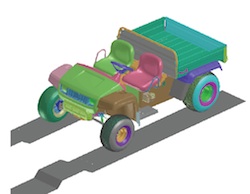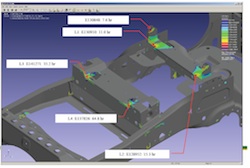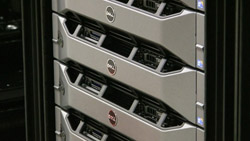Taming Tough Duty Cycles: Digital Manufacturing at John Deere
“It’s like a beefed up golf cart,” says Mohamad El-Zein, describing John Deere’s sturdy all-terrain Gator(TM) Utility Vehicle.
 El-Zein is the manager of Metals and Mechanics at the company’s Moline Technology and Innovation Center. He likes to use the Gator to explain his group’s approach to using the tools of digital manufacturing – such as multiphysics simulations that leverage finite element analysis (FEA) and computational fluid dynamics (CFD) – to tackle difficult mechanical and manufacturing problems.
El-Zein is the manager of Metals and Mechanics at the company’s Moline Technology and Innovation Center. He likes to use the Gator to explain his group’s approach to using the tools of digital manufacturing – such as multiphysics simulations that leverage finite element analysis (FEA) and computational fluid dynamics (CFD) – to tackle difficult mechanical and manufacturing problems.
(Editor’s Note: El-Zein will be discussing the work of his group at the upcoming R Systems HPC360 conference to be held Dec. 13-14, Champaign, Ill.)
The company’s products are made for heavy duty work in environments that range from the farm to the battlefield, and they have to be built to last. As El-Zein dryly comments, “Our customers don’t like cracks.”
Each John Deere piece of equipment – whether it’s a huge farm combine or the Gator, the Jack Russell of off road vehicles – is designed with a “duty cycle” in mind. Duty cycles range from the average wear and tear that a vehicle might encounter from normal driving to the stresses and strains generated by operators who are really tough on their equipment. Deere designs for the latter group – if the equipment can stand up to the most difficult operating conditions it is likely to encounter, the average, more forgiving driver is going to be very satisfied with the machine’s performance.
“We collect histories of use and abuse and then test the products in the lab,” El-Zein says. Back in what he refers to the “good old days,” that primitive era before the introduction of digital modeling and simulation, they would test the impact of mechanical loads on such vulnerable areas as joints, bolts and welds by pushing the machine until it broke. This was time-consuming, expensive, and not always that revealing. “In the old days we just took care of the mechanical loads and when something did not work well, we’d blame the manufacturing guys,” he says with a laugh.
The Move to Digital
Now all that has changed.
 Using their in-house high performance computing (HPC) cluster, the Metals and Mechanics group will essentially build a vehicle like the Gator digitally and then, using commercial and homegrown FEA and other software solvers, simulate how its components respond to various stresses and strains generated by a wide variety of environments and activities.
Using their in-house high performance computing (HPC) cluster, the Metals and Mechanics group will essentially build a vehicle like the Gator digitally and then, using commercial and homegrown FEA and other software solvers, simulate how its components respond to various stresses and strains generated by a wide variety of environments and activities.
However, El-Zein cautions, it’s one thing to simulate a vehicle moving over solid ground such as a highway. But this is not the natural habitat for a piece of John Deere equipment. For example, the Gator finds itself bumping over ruts and rocks on soil with changing viseoelastic compaction characteristics. How does this translate into mechanical forces that can cause bolts to loosen and welds to crack? And how can you model these complex scenarios and run the simulations in a reasonable amount of time?
Recently, one of John Deere’s suppliers used their cluster to run an explicit finite element analysis that encompassed a mere three seconds of real time – a fraction of a duty cycle. The HPC computer system, using 32 cores, took six days to complete the job.
El-Zein would like to run this simulation for the component’s full duty cycle of 800 seconds, but, as he says, “Do the math.”
The reason for employing as much computational horsepower as possible is that the devil is in the details. “It’s the little things that will bite you,” he comments.
For example, in the not-too-distant past when creating a model of a typical weld, their simulations were based on weld angles exhibiting a perfect 45 degree angle. But they were modeling perfection – in real life, weld angles and each weld radius is all over the lot; every deviation from the ideal exhibits different characteristics when subjected to heat and other distortions.
“There is no getting around it,” El-Zein says. “You have to go to reality and measure.”
 The Metals and Mechanics group’s response was to go on to the factory floor and build an extensive library of actual weld angles and radii. This allows them to generate weld models that exhibit a wide range of characteristics under different conditions. This allows them to optimize the model to create a component or entire system that can not only handle the strains associated with heavy duty cycles, but also account for variability in the manufacturing process.
The Metals and Mechanics group’s response was to go on to the factory floor and build an extensive library of actual weld angles and radii. This allows them to generate weld models that exhibit a wide range of characteristics under different conditions. This allows them to optimize the model to create a component or entire system that can not only handle the strains associated with heavy duty cycles, but also account for variability in the manufacturing process.
Running fine grained CFD simulations of the granular and irregular nature of the soil the vehicle will have to traverse; creating highly detailed meshes for FEA analysis; performing multi-physics simulations of welding; or modeling the equipments bolts and their response to a wide variety of mechanical factors, is stretching the limits of the group’s in-house cluster.
Tapping into NCSA HPC Capabilities
Fortunately, not too far down the road is the National Center for Supercomputing Applications (NCSA), located at the University of Illinois at Urbana-Champaign. NCSA’s Private Sector Program not only offers time on its powerful supercomputers, but also skilled staff members and researchers to help companies like John Deere tackle their most demanding high performance computing requirements. In fact, a third of the Fortune 500 – companies like Boeing, Caterpillar, Dell, Microsoft, and Procter & Gamble – either are or have been Program customers.
Which is why El-Zein is currently talking with Merle Giles, head of the Private Sector Prog ram. Now available through the program is time on Forge, a 153 teraflop supercomputer that combines both CPUs and general-purpose graphical processing units (GPUs).
ram. Now available through the program is time on Forge, a 153 teraflop supercomputer that combines both CPUs and general-purpose graphical processing units (GPUs).
The computational horsepower available at NCSA will allow the John Deere engineers to run many more models of far greater complexity, including simulations that include the entire vehicle.
The result will be a better product, faster time to market, and satisfied customers – even those customers who treat their Gators like fugitives from a demolition derby.










